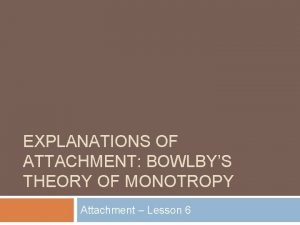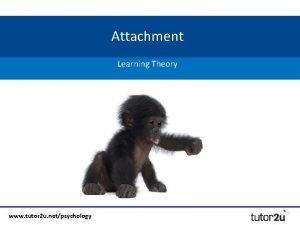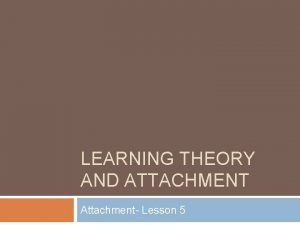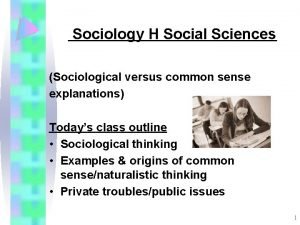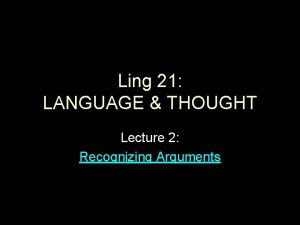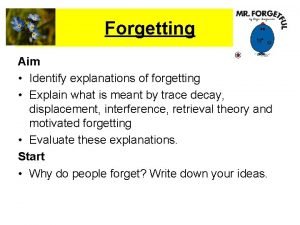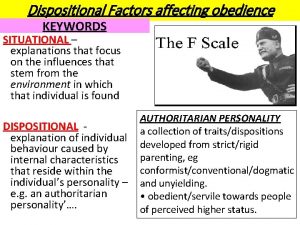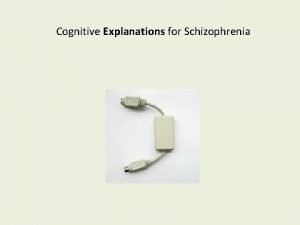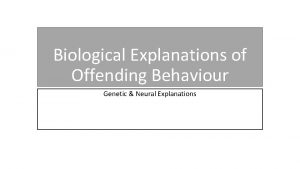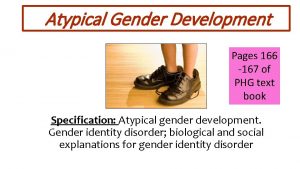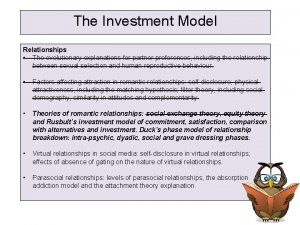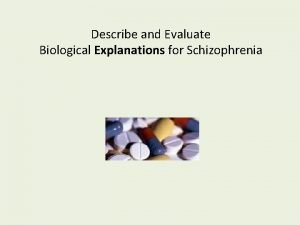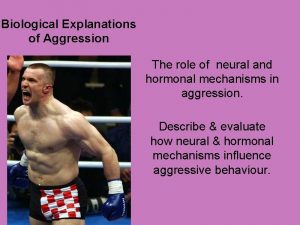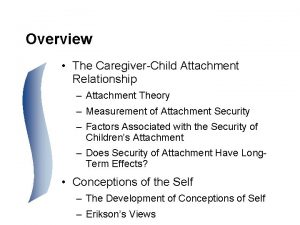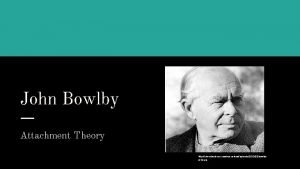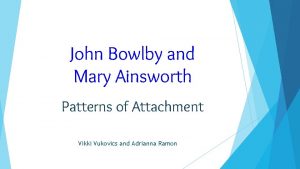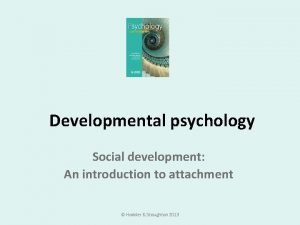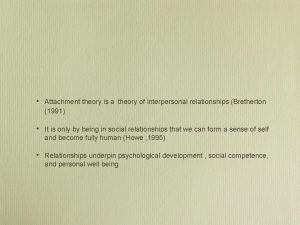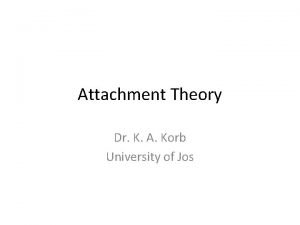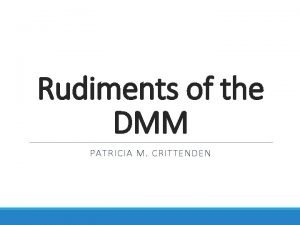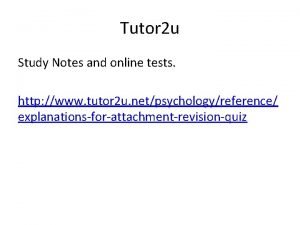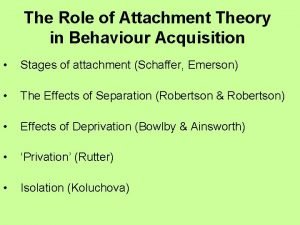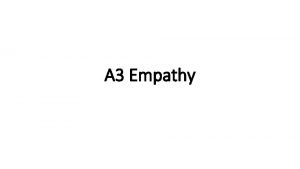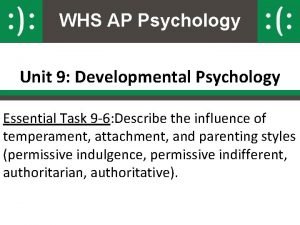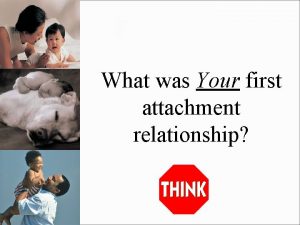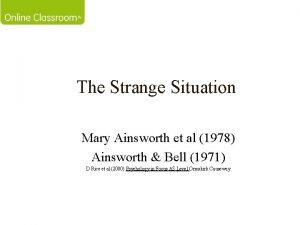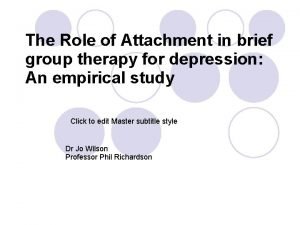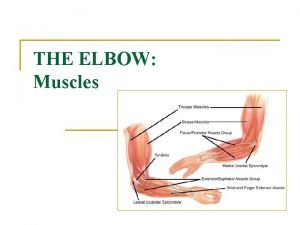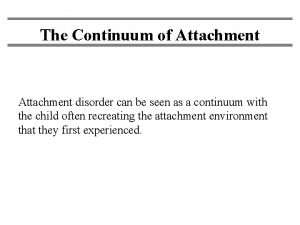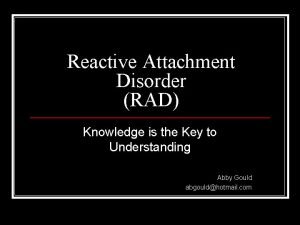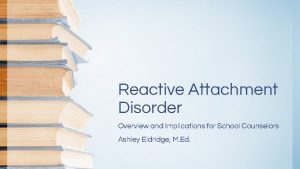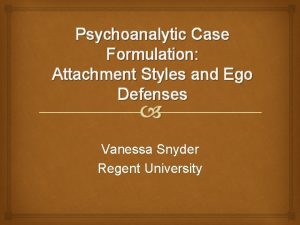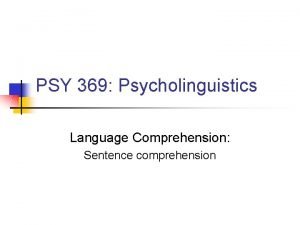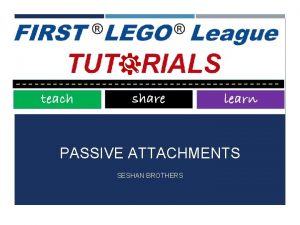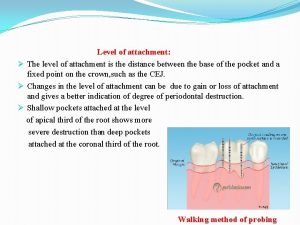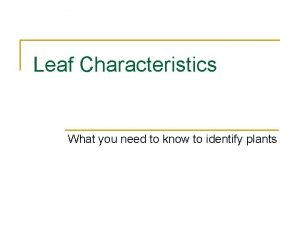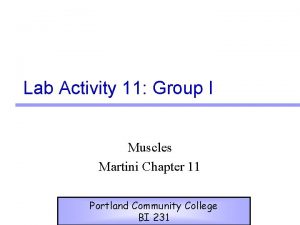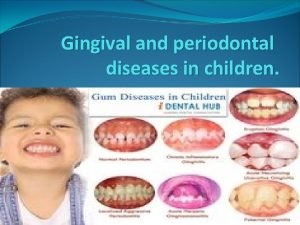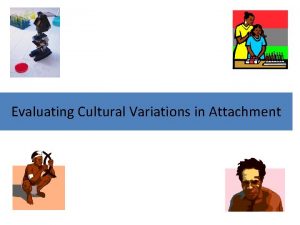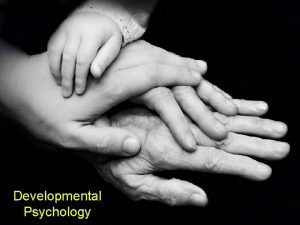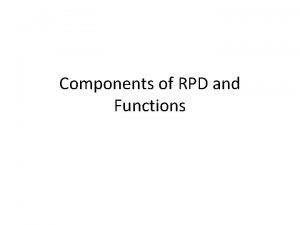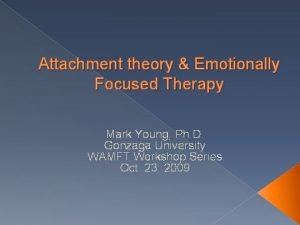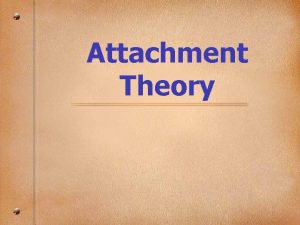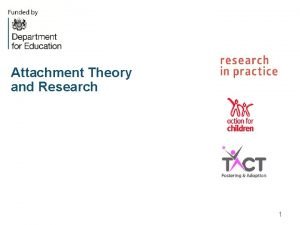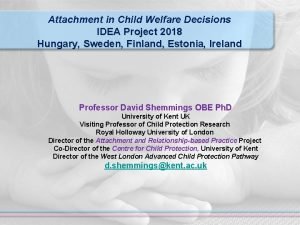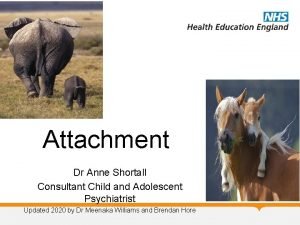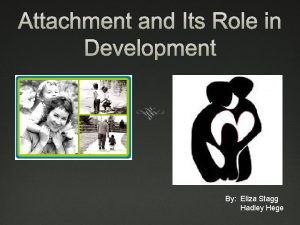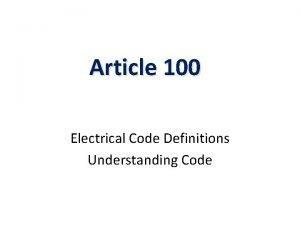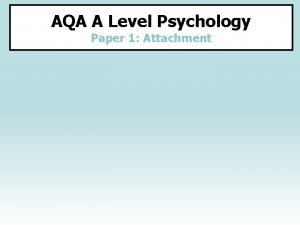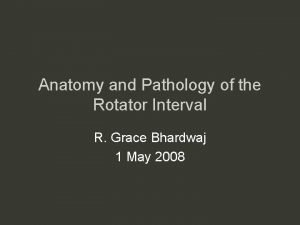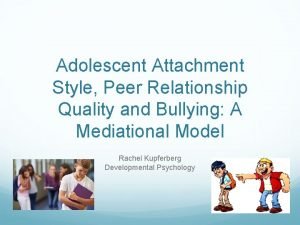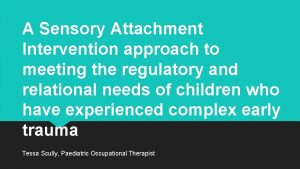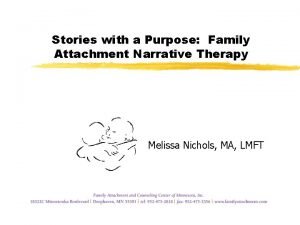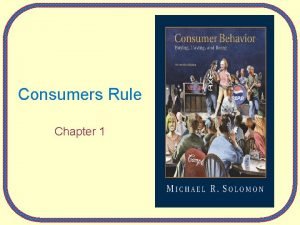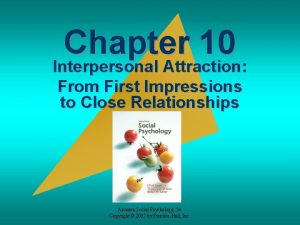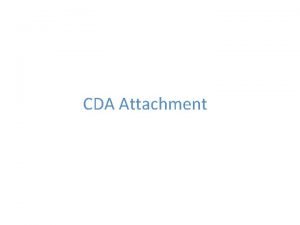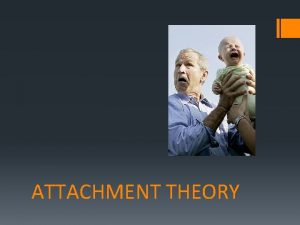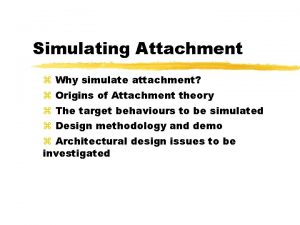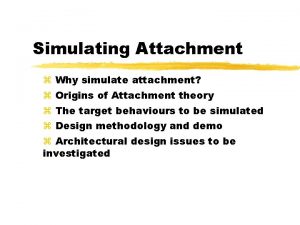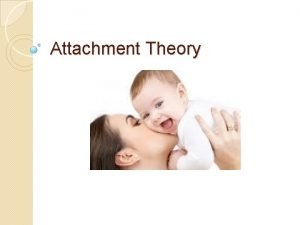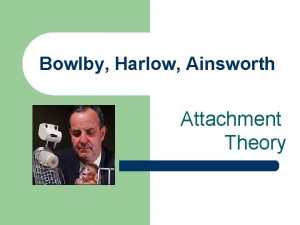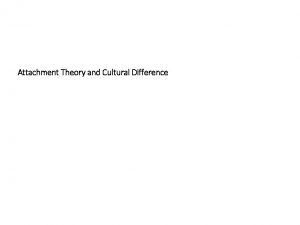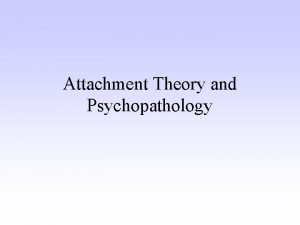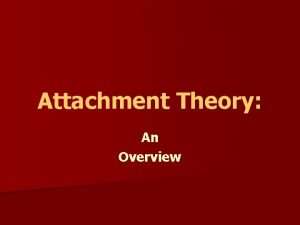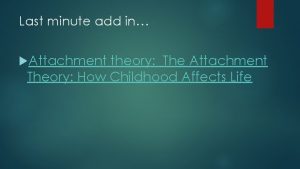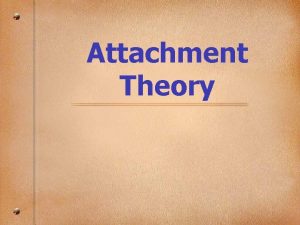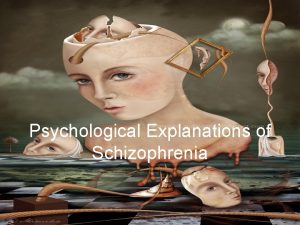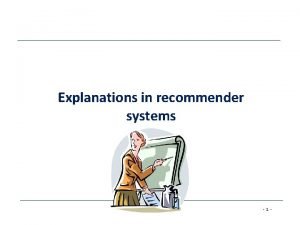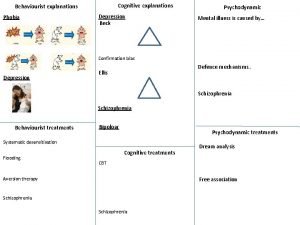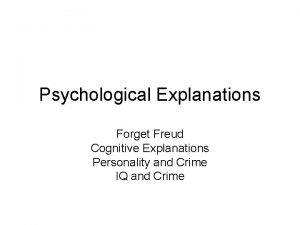3 3 Explanations of attachment Learning Theory Vs








































































- Slides: 72

3. 3 Explanations of attachment Learning Theory Vs Evolutionary Theory

Maccoby (1980) identified four characteristics of attachment:

The infant seeks proximity, trying to stay near the caregiver

Both the infant and caregiver feel distressed when separated.

Both the infant and caregiver feel pleasure when reunited http: //www. youtube. com/watch? v=w. DZUf. GBUSe. Y

The infant is generally always aware of the caregiver and makes frequent contact.

The Specification!

Starter review – How do Babies Attach? If this is the answer – what was the question? Shaffer’s Stages of Attachment Imprinting Sensitive Period Critical Period Cloth Comfort

Recap: The Role of Fathers True or False Activity

Attachment Evolutionary perspective Learning Theory Perspective The tendency to form attachments is INNATE! Infants have no INNATE tendency to form attachments Tendency is present in both infants and mothers They learn attachments because of food

Learning Theory: Basic Assumptions • All behaviour is learnt through experience via the process of association. • Attachment – infant learns to associate caregiver with food. • Cupboard Love Theory

Classical Conditioning – Key Concepts Conditioning UCS CS UCR CR

Ivan Pavlov 1849 -1936 http: //www. simplypsychology. pwp. blueyonder. co. uk/pavlov. html

Pavlov’s Dogs Activity: Create your own version of this that would explain attachment in babies

Key Terms: Unconditioned stimulus (UCS) • The stimulus that produces a reflex response. • Dog Food Unconditioned response (UCR) • The reflex response to a UCR • Salivation Conditioned Stimulus (CS) Conditioned Response (CR) • a new stimulus presented with the UCS • Bell • the response which is learnt • Drooling at bell.

“You don’t have to be at home to be an attachment parent” • Learning Theory: the belief that attachments develop through conditioning processes. • Classical conditioning: when a response produced naturally by a certain stimulus, becomes associated with another stimulus that is not normally associated with that particular response

Key Words • Learning Theory: the belief that attachments develop through conditioning processes. • Classical conditioning: when a response produced naturally by a certain stimulus, becomes associated with another stimulus that is not normally associated with that particular response. • Operant Conditioning: learning occurring via reinforcement of behaviour, thus increasing the chances of the behaviour occurring again. • Cupboard Love Theory: the belief that attachments are formed with people who feed infants.

Classical Conditioning

Result

Operant Conditioning – Key Concepts Positive Reinforcement Negative Reinforcement Punishment Law of effect

Thorndike (1898) Cat Puzzle Box A: To investigate the effect of consequences on learned behaviour. M: He created a puzzle box for a cat. He observed what happened. R: He noticed that a hungry cat would learn how to open the box and get to the food (reward) C: The cat had learnt to associate opening the box and getting a pleasant

Thorndike’s – Law of Effect Behaviours that are followed by rewards are usually repeated. “If a certain response has pleasant consequences, it is more likely than other responses to occur”

Skinner’s Box

Skinner’s Key Concepts Punishment Reinforcement • Weakens behaviour because it is unpleasant and we try to avoid it. • • A consequence of behaviour that encourages or strengthens a behaviour. • Positive Reinforcement • A reward or pleasant consequence that increases the likelihood that a behaviour will be repeated • Negative Reinforcement • When an unpleasant experience is removed after a behaviour has been performed. This makes it more likely that the behaviour will be repeated.

Burrhus F. Skinner Operant Conditioning Humans are not passive, they do not wait around for stimuli - they engage with their environments. Behaviour is determined by the consequences of past behaviour. consequence What it involves Behaviour Positive Reinforcement (REWARD) Something it likes (food) strengthened Punishment Something it does not like (electric shock to paw) weakened Negative Reinforcement Something it does not like (electrify the floor) strengthened

Activity : Operant Conditioning Create a flow diagram to explain how the following could be used to strengthen the attachment bond. Being Fed Hugs when crying Being Ignored

Evaluation of Learning Theory L Learning theory is reductionist. Attachment is a complex behaviour with an emotional and cognitive component. L Babies attach to adults who do not necessarily feed them. L Babies do not live to eat but eat to live – they actively seek stimulation not passively receive nutrition. L Babies need constant emotional security not food.

Today we are going to look at…. Evolution

What is evolution?

Darwin’s Dangerous Idea Darwin (1859) publishes "On the Origin of Species by Means of Natural Selection".

Evolution is… • Evolution is a process whereby useful features are introduced in the species. • Features are useful if they help the animal survive long enough to reproduce. • To survive and reproduce animals need to be well adapted to their environment • Useful features are therefore called ADAPTIVE

What does “SURVIVAL of the FITTEST” mean?

FUTURE GENERATIONS

Fitness

Fitness Yummy!

Fitness: Which ones will survive Damn. Arse.

Evolution & Psychology Activity Use evolutionary psychology to explain the following behaviour: Rooting Reflex Friendships - our need to be social beings Fight or Flight Sporting Prowess Altruism (helpfulness) Musical ability Fashion sense Humour

What has evolution got to do with attachment?

Evolution theory basically sees attachment as an animals instinct What is the instinct?

Bowlby (1969) suggested that attachment was important for survival!!!

How would attachment help with an infants survival? Discuss…

Forming an attachment may give a newborn an advantage over a newborn that does not form an attachment, by ensuring a good source of food and protection from harm

Why would biological parents have an instinct to form an attachment with their young? Discuss… (Think about previous slides)

Biological Parents It is their instincts to form an attachment too. If this happens, then the child (who carries the parents genes) will hopefully reproduce and pass on their genes to the next generation.

Animal Research Attachment

Imprinting

Lorenz (1935)

Harlow’s Monkeys

Attachment is a form of human imprinting



Bowlby’s Monotropic Theory • Evolutionary explanation of attachment. • Influenced by classic animal studies of Lorenz and Harlow. • Monotropic theory – infants have an innate tendency to make an attachment with one attachment figure, usually the mother.

Emotional bonds have evolutionary functions. • Emerged in stone-age • Evolved through natural selection so offspring would stay close to their caregivers. • Genetically programmed behaviour to ensure species survival.

Bowlby’s Monotropic Theory Social releasers Critical time period Internal working model

Social Releasers Infants and carers have innate programming to become attached, these characteristics are called social releasers. • Crying • Smiling • Clinging So, social releasers elicit caregiving in other people, it is adaptive for babies to display these behaviours because it ensures their own survival. Hearing a baby cry makes us uncomfortable so we are driven to care for the baby so that it will stop crying. We like seeing a baby smile and we automatically smile back. Humans are innately programmed to respond to such behaviours because it is adaptive, it ensures the survival of the baby and therefore our own genes.

How do you respond to a baby laughing? https: //www. youtube. com/watch? v=bk 0 er. H 6 b. Qq. I

Babies crying https: //www. youtube. com/watch? v=7 h. S 08 Xs. I 6 Vg

Babies following and clinging

Critical period • Stemmed from the work of ethologists e. g. Lorenz – imprinting. • A period in development during which an individual is especially impressionable • (a window of opportunity) • Bowlby believed an att. must form within the first 3 years of a child’s life.

Internal working model “Love in infancy is as important for mental health as vitamins and proteins for physical health”

Internal Working Model • The monotropic attachment is unique; it is the first to develop and the strongest bond of all. • Forms a model / template / blueprint for all future relationships. • Continuity hypothesis – there is consistency between early emotional experiences and later relationships.

Evaluation J Research evidence– Lorenz – Shaffer & Emerson (one primary attachment). L Used by New Right to keep women in the home. L Animals are different to humans – animals born mobile to maybe imprinting more important. L Attachment requires more than mere exposure to primary attachment – sensitive response. L Fathers seen as secondary or minor attachment figures – Fathers can be attachment figures in their own right.

Exam Questions: 1. Explain what is meant by internal working model. (3 marks) 2. Explain what is meant by monotropic theory of attachment. (2 marks) 3. Outline Bowlby’s theory of attachment, include reference to the critical period and internal working models. (6 marks) 4. Outline two criticisms of learning theory as an explanation of attachment. (4 marks) 5. Outline and evaluate learning theory as an explanation of attachment. (12 marks) 6. Describe and evaluate Bowlby’s monotropic theory of attachment. (12 marks).

Next Week …

Bowlby Vs Learning Theory In the red corner. . In the blue corner. .

Round 1 Who uses argues attachment is due to cupboard love’?

Round 2 Who suggests attachment is a human form of imprinting?

Round 3 Whose theory ignores the emotional part of attachment?

Round 4 Who was inspired by Lorenz and Harlow?

Round 5 Who said …“If a certain response has pleasant consequences, it is more likely than other responses to occur”

Round 6 Who was inspired by Lorenz and Harlow?

Round 7 Explain what is meant by social releasers?
 Monotropy theory
Monotropy theory Tutor 2 u psychology
Tutor 2 u psychology Outline and evaluate the learning theory of attachment
Outline and evaluate the learning theory of attachment Examples of common sense and sociological explanations
Examples of common sense and sociological explanations Premise indicators
Premise indicators Explanations for forgetting
Explanations for forgetting Dispositional factors affecting obedience
Dispositional factors affecting obedience Cognitive explanations of schizophrenia
Cognitive explanations of schizophrenia Dust bowl migration map
Dust bowl migration map Bolshevik revolution cartoon
Bolshevik revolution cartoon Evaluate the atavistic form explanation for offending
Evaluate the atavistic form explanation for offending Neural explanations of offending behaviour
Neural explanations of offending behaviour Gender dysphoria biological explanations
Gender dysphoria biological explanations Evolutionary explanations for partner preferences
Evolutionary explanations for partner preferences Biological explanations of schizophrenia
Biological explanations of schizophrenia Biological explanations of aggression
Biological explanations of aggression Bowlby's attachment
Bowlby's attachment Attachment theory bowlby
Attachment theory bowlby Ainsworth's strange situation
Ainsworth's strange situation What was john bowlby attachment theory
What was john bowlby attachment theory Bowlby attachment theory
Bowlby attachment theory Attachment theory bowlby
Attachment theory bowlby The attachment theory
The attachment theory Dmm attachment theory
Dmm attachment theory Outline and evaluate bowlby's monotropic theory 8 marks
Outline and evaluate bowlby's monotropic theory 8 marks Schaffer and emerson
Schaffer and emerson Empathy theories johannes volkelt
Empathy theories johannes volkelt Cuadro comparativo e-learning m-learning b-learning
Cuadro comparativo e-learning m-learning b-learning Parents impose rules and expect obedience
Parents impose rules and expect obedience First attachment
First attachment In mary ainsworth's strange situation experiment
In mary ainsworth's strange situation experiment Role attachment
Role attachment Where is tricep muscle located
Where is tricep muscle located Continuum of attachment
Continuum of attachment Asc 52 attachment
Asc 52 attachment Medial rotation of tibia
Medial rotation of tibia Swing lock denture diagram
Swing lock denture diagram Rad psychology definition
Rad psychology definition Reactive attachment disorder symptoms
Reactive attachment disorder symptoms Ego defenses
Ego defenses Immediacy principle linguistics
Immediacy principle linguistics Fll passive attachments
Fll passive attachments Gingival attachment
Gingival attachment Block style letter vs modified
Block style letter vs modified Fascicled leaf
Fascicled leaf Omohyoid muscle origin and insertion
Omohyoid muscle origin and insertion Asc 52 attachment
Asc 52 attachment Lamina dura radiografi
Lamina dura radiografi Cultural variations in attachment evaluation
Cultural variations in attachment evaluation Employee attachment
Employee attachment Nerves of abdominal wall
Nerves of abdominal wall Contact comfort psychology definition
Contact comfort psychology definition Attachment issues meaning
Attachment issues meaning Lathe machine advantages and disadvantages
Lathe machine advantages and disadvantages Types of minor connectors in rpd
Types of minor connectors in rpd Classification of fixed partial denture
Classification of fixed partial denture Healthy emotional attachment
Healthy emotional attachment Ainsworth experiment
Ainsworth experiment Objectives of attachment
Objectives of attachment Disorganised attachment checklist
Disorganised attachment checklist Examples of disorganized attachment
Examples of disorganized attachment Dismissive avoidant attachment
Dismissive avoidant attachment An attachment plug establishes connection between ____.
An attachment plug establishes connection between ____. Attachment psychology a level
Attachment psychology a level Coracohumeral
Coracohumeral Attachment styles in relationships
Attachment styles in relationships Sensory attachment intervention
Sensory attachment intervention Family attachment narrative therapy
Family attachment narrative therapy Semiprecision attachment
Semiprecision attachment Pleasers and controllers
Pleasers and controllers Self concept attachment
Self concept attachment Attachment styles in relationships
Attachment styles in relationships Consumer behavior chapter 1
Consumer behavior chapter 1
